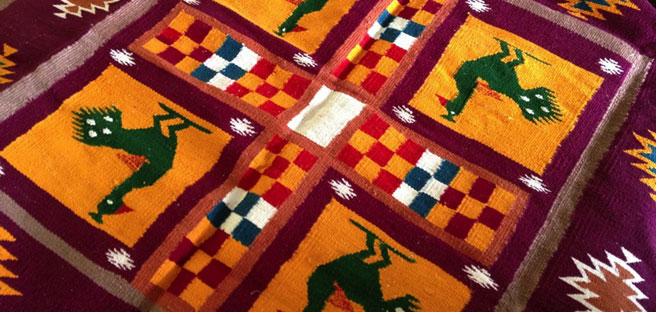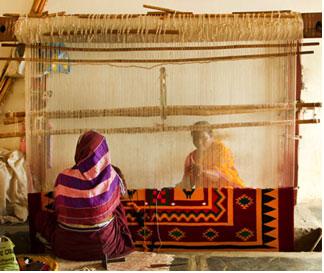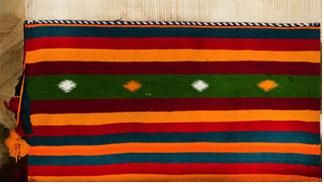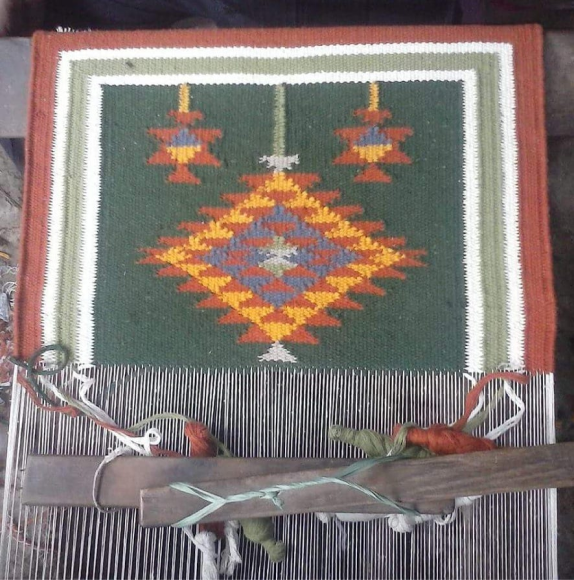Navalgund Jamkhanas
Navalagund, near Dharwad in Karnataka, is renowned for its Jamkhana durries, which are floor covering mats used during weddings and events. These durries stand out due to their unique structure, bold colors, and distinctive form. The craft originated during the rule of Ali Adil Shah of Bijapur in the 16th century. Weavers migrated from Bijapur to Navalgund during the conflict between the Deccan Sultanate and the Vijayanagar Empire. The name “Navalgund” translates to “peacock” in Kannada, and the pattern of the jamkhana incorporates the image of this bird, which is abundant in the area.

The process of making Jamkhana durries involves weaving on a vertical loom known as Khadav Magga. Yarn is purchased and dyed locally, with six cotton yarns plied together to form a weft. The looms are installed in the corners of houses, combining elements of a pit loom and a vertical loom. Heddles are created to raise and lower the warp yarns, and the weaving is mainly done indoors by women. The weavers work from their experience and memory, giving each jamkhana a unique touch. After the yarns are fully inserted, the durries are taken off the loom and trimmed.

Traditional Jamkhana designs are characterized by geometric and simplified natural forms. The dominant color used is red, with yellow, green, black, and white as accenting colors. The motifs in the jamkhanas have names based on geometrical shapes, such as zigzag diamond shapes, wave patterns, and vertical or horizontal stripes. Jamkhana durries come in various sizes and are primarily used as floor mats. Some specific designs include Tottale Jamkhana, Sadaphul, Bada Mor, Char Mor, and Guddara.

Warangal Dhurries
Warangal dhurries are traditional handwoven rugs that originate from the city of Warangal in Telangana, India. These dhurries are renowned for their vibrant colors, intricate designs, and exceptional craftsmanship. Made using a combination of cotton and wool, they are known for their durability and versatility, serving as both decorative pieces and functional floor coverings. Warangal dhurries showcase the rich textile heritage of the region and continue to be cherished for their cultural significance and timeless beauty.

The tools used in the making of Warangal dhurries include a loom, shuttle, and comb for weaving, as well as needles for embroidery. The raw materials primarily consist of cotton and wool yarns, which are sourced and prepared for weaving. Natural dyes derived from plants and minerals are often used to create the vibrant colors that adorn the dhurries, adding to their visual appeal.
The yarns, either cotton or wool, are prepared by cleaning and spinning them. Artisans make detailed designs on paper as a guide for weaving the dhurries, using traditional patterns. The loom is set up by securing the threads and creating a base for weaving. Skilled weavers use tools like a shuttle and comb to weave the threads together, forming the patterns. Sometimes, extra decorations are added with embroidery or colorful threads. The finished dhurries are checked for any issues, trimmed, and the edges are secured. They are washed to remove dirt and excess dye, then dried under the sun to regain their texture and color. Before being sold, the dhurries go through a final quality check and any necessary fixes are made.
Warangal dhurries are exquisite handwoven rugs known for their intricate patterns and vibrant colors, adding a touch of traditional elegance to any space. These durable and versatile textiles are perfect for adding warmth and style to floors, walls, or as decorative accents in homes and interiors.


